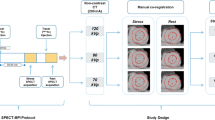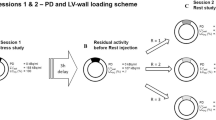Abstract
Purpose
In clinical routine, attenuation correction (AC) using X-ray CT is a relatively new method for reducing attenuation artefacts. We evaluated the quality of attenuation maps generated with very low tube current to minimise exposure due to transmission scanning.
Methods
SPECT/CT acquisitions were performed with a Millenium VG3 gamma camera with the Hawkeye CT device (GE Medical Systems). In phantom studies, determination of linear absorption coefficients (μ) for air, water and Teflon was carried out. The attenuation maps in both stress and resting studies from 62 patients (21 females and 41 males, age 63.7 ± 11.0 years, BMI 30.0 ± 5.7 kg/m2) were compared. All patients underwent exercise or pharmacologic stress testing and a resting study for comparison using Tc-99m MIBI or Tc-99m Tetrofosmin. AC in stress studies was performed using 2.5 mA tube current (set as default), whereas 1.0 mA was used in resting studies.
Results
In both phantom and patient studies, differences of linear absorption coefficients were not significant (p > 0.05). Effective dose decreased from 0.90 mSv down to 0.36 mSv, respectively.
Conclusion
Our results indicate that reliable attenuation maps (μ-maps) of the thorax can be obtained even with the use of very low tube current. In our study, radiation exposure in CT-based AC for myocardial perfusion SPECT was substantially lowered (60% reduction). This is of particular importance in high-risk patients who may have to undergo follow-up scans and in research studies on volunteers. The procedure introduced is relatively simple and can be transferred to other SPECT/CT devices, which allow adjustment of tube current.








Similar content being viewed by others
References
Bateman TM, Cullom SJ. Attenuation correction single-photon emission computed tomography myocardial perfusion imaging. Semin Nucl Med. 2005;35:37–51.
Blankespoor SCWX, Kalki K, et al. Attenuation correction of SPECT using x-ray CT on an emission-transmission CT system. IEEE Trans Nucl Science. 1996;43:2263–74.
Delbeke D, Coleman RE, Guiberteau MJ, et al. Procedure guideline for SPECT/CT imaging 1.0. J Nucl Med. 2006;47:1227–34.
Heller G, Links J, Bateman T, et al. American Society of Nuclear Cardiology and Society of Nuclear Medicine joint position statement: Attenuation correction of myocardial perfusion SPECT scintigraphy. J Nucl Cardiol. 2004;11:229.
Masood Y, Liu YH, Depuey G, et al. Clinical validation of SPECT attenuation correction using x-ray computed tomography-derived attenuation maps: Multicenter clinical trial with angiographic correlation. J Nucl Cardiol. 2005;12:676–86.
Nosske DMV, Brix G. Establishment and application of diagnostic reference levels for nuclear medicine procedures in Germany (in German). Nuklearmedizin. 2004;43:79–84.
Bocher M, Balan A, Krausz Y, et al. Gamma camera-mounted anatomical x-ray tomography: Technology, system characteristics and first images. Eur J Nucl Med. 2000;27:619–27.
Fricke H, Fricke E, Weise R, et al. A method to remove artifacts in attenuation-corrected myocardial perfusion SPECT introduced by misalignment between emission scan and CT-derived attenuation maps. J Nucl Med. 2004;45:1619–25.
Fricke E, Fricke H, Weise R, et al. Attenuation correction of myocardial SPECT perfusion images with low-dose CT: Evaluation of the method by comparison with perfusion PET. J Nucl Med. 2005;46:736–44.
McNitt-Gray MF. AAMP/RSNA physics tutorial for residents: Topics in CT: Radiation dose in CT. Radiographics. 2002;22:1541–53.
Jessen KA, Shrimpton PC, Geleijns J, Panzer W, Tosi G. Dosimetry for optimisation of patient protection in computed tomography. Appl Radiat Isot. 1999;50:165–72.
Society of Nuclear Medicine. Procedure guideline for myocardial perfusion imaging (version 3.0). 2002.
Thompson RC, Cullom SJ. Issues regarding radiation dosage of cardiac nuclear and radiography procedures. J Nucl Cardiol. 2006;13:19–23.
DePuey GE, American Society of Nuclear Cardiology. Imaging guidelines for nuclear cardiology procedures. J Nucl Cardiol 2006;13:e1–151.
Zaidi H. Is MR-guided attenuation correction a viable option for dual-modality PET/MR imaging? Radiology. 2007;244:639–42.
Cherry SRSJ, Phelps ME. Physics in nuclear medicine, 3rd edn. Philadelphia, PA, USA: Saunders; 2003.
Burger C, Goerres G, Schoenes S, et al. PET attenuation coefficients from CT images: Experimental evaluation of the transformation of CT into PET 511-kev attenuation coefficients. Eur J Nucl Med Mol Imaging. 2002;29:922–7.
Kamel E, Hany TF, Burger C, et al. CT vs GE-68 attenuation correction in a combined PET/CT system: Evaluation of the effect of lowering the CT tube current. Eur J Nucl Med Mol Imaging. 2002;29:346–50.
Kalra MK, Maher MM, Toth TL, et al. Strategies for CT radiation dose optimization. Radiology. 2004;230:619–28.
McCollough CH, Bruesewitz MR, Kofler JM Jr. CT dose reduction and dose management tools: Overview of available options. Radiographics. 2006;26:503–12.
Zaidi H, Hasegawa B. Determination of the attenuation map in emission tomography. J Nucl Med. 2003;44:291–315.
O’Connor M, Kemp B, Anstett F, et al. A multicenter evaluation of commercial attenuation compensation techniques in cardiac SPECT using phantom models. J Nucl Cardiol. 2002;9:361–76.
Tonge CM, Manoharan M, Lawson RS, Shields RA, Prescott MC. Attenuation correction of myocardial SPECT studies using low resolution computed tomography images. Nucl Med Commun. 2005;26:231–7.
Goetze S, Pannu HK, Wahl RL. Clinically significant abnormal findings on the “nondiagnostic” CT portion of low-amperage-CT attenuation-corrected myocardial perfusion SPECT/CT studies. J Nucl Med. 2006;47:1312–8.
Grossman G, Garcia E, Bateman T, et al. Quantitative Tc-99m sestamibi attenuation-corrected SPECT: Development and multicenter trial validation of myocardial perfusion stress gender-independent normal database in an obese population. J Nucl Cardiol. 2004;11:263–72.
Heller G, Bateman T, Johnson L, et al. Clinical value of attenuation correction in stress-only Tc-99m sestamibi SPECT imaging. J Nucl Cardiol. 2004;11:273–81.
Slomka PJ, Fish MB, Lorenzo S, et al. Simplified normal limits and automated quantitative assessment for attenuation-corrected myocardial perfusion SPECT. J Nucl Cardiol. 2006;13:642–51.
Almeida P, Bendriem B, de Dreuille O, et al. Dosimetry of transmission measurements in nuclear medicine: A study using anthropomorphic phantoms and thermoluminescent dosimeters. Eur J Nucl Med. 1998;25:1435–41.
Perisinakis K, Theocharopoulos N, Karkavitsas N, Damilakis J. Patient effective radiation dose and associated risk from transmission scans using GD-153 line sources in cardiac SPECT studies. Health Phys. 2002;83:66–74.
Bellemann ME, Riemann S, Kapplinger S, Brix G, Gottschild D. Assessment of radiation exposure caused by transmission scans in SPECT: An anthropomorphic dosimetry study]. Biomed Tech (Berl). 2002;47(Suppl 1 Pt 1):474–5.
Kammeier A. Attenuation correction using the transmission-emission system Beacon TM in myocardial perfusion imaging. Effects on tracer distribution in left ventricular myocardium and clinical role in diagnosis of coronary artery disease (in German). Thesis, Ruhr University Bochum; 2004. Available at http://deposit.ddb.de/cgibin/dokserv?idn=976431947&dok_var=d1&dok_ext=pdf&filename=976431947.pdf
Preuss R, Lindner O, Weise R, Fricke E, Burchert W. Reduction of radiation exposure in x-ray computed tomography-derived attenuation correction for myocardial SPECT perfusion imaging. J Nucl Med Meeting Abstracts. 2006;47:257P.
Acknowledgement
Preliminary results of this study were presented at the 2006 annual meeting of the Society of Nuclear Medicine [32]. The authors thank the technical staff of our institution for excellent technical support.
Conflict of interest statement
The authors certify that there is no actual or potential conflict in relation to this article.
Author information
Authors and Affiliations
Corresponding author
Rights and permissions
About this article
Cite this article
Preuss, R., Weise, R., Lindner, O. et al. Optimisation of protocol for low dose CT-derived attenuation correction in myocardial perfusion SPECT imaging. Eur J Nucl Med Mol Imaging 35, 1133–1141 (2008). https://doi.org/10.1007/s00259-007-0680-2
Received:
Accepted:
Published:
Issue Date:
DOI: https://doi.org/10.1007/s00259-007-0680-2




